New combined electric and petrol Kawasaki works well, with revolutionary tech
It’s not often you can genuinely say a bike has completely moved technology on. Even the latest flagship adventure tourers or superbikes all have the same fundamental layout: a petrol engine, steel or aluminium frame, two wheels with drive at the rear, rear swinging arm and front fork suspension setups.
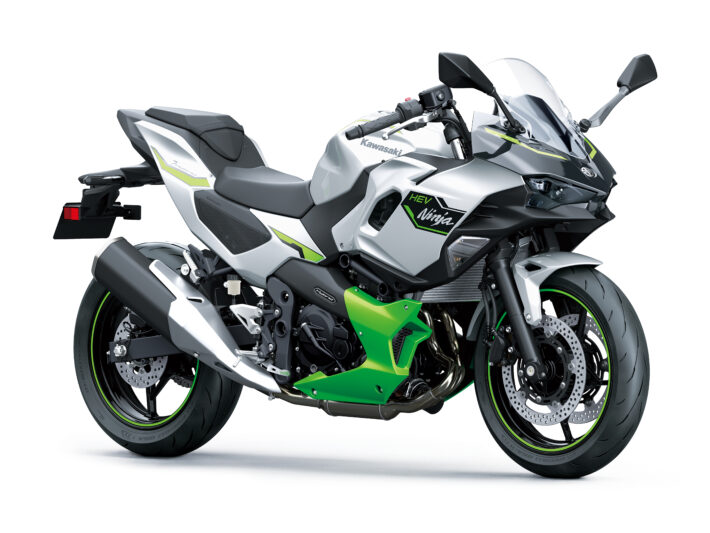
Yamaha’s three-wheeled leaning Niken is maybe one of the few machines to buck the trend of late (though is it even a bike?)
Electric bikes have a case to argue of course – but we’ve had battery-powered machines for decades now, for good or ill, and while the likes of an Energica Experia or Ego look good and work well enough, they’ve not quite moved the state of the art on very far.
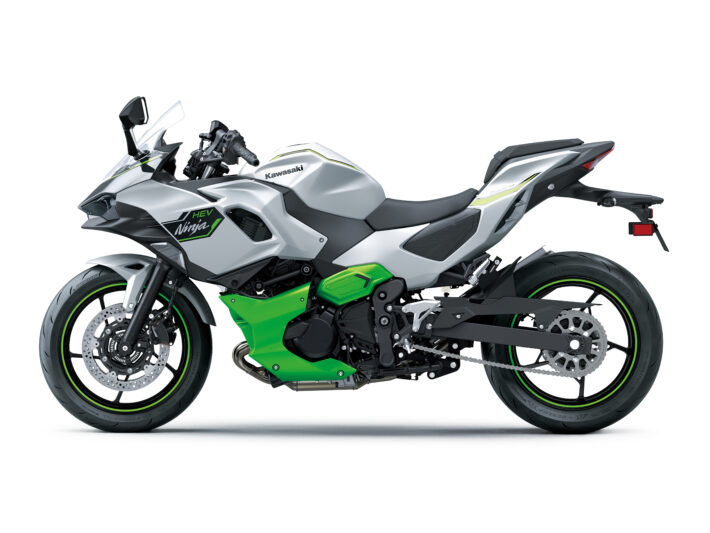
But the bike in front of me, parked up outside a nice hotel in Barcelona, is pretty undeniable when it comes to revolutionary tech. It’s the new Kawasaki Ninja 7 hybrid bike – which combines a petrol engine and an electric motor with a moderate-sized battery pack – and there’s really nothing like it out there at the moment.
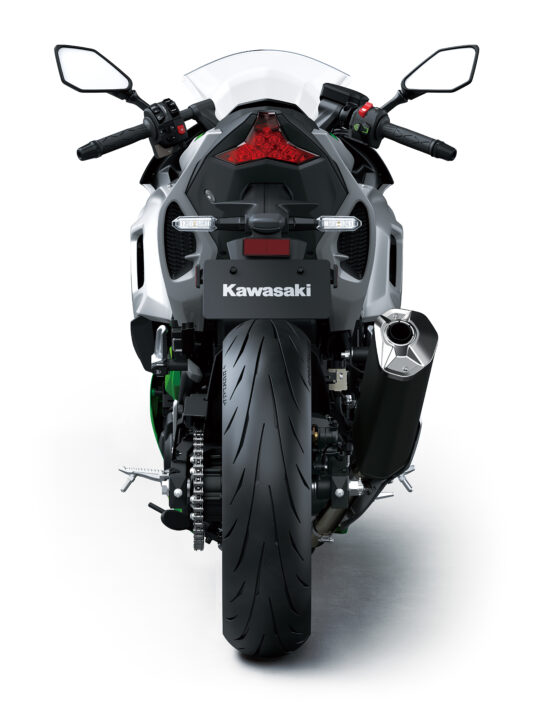
We’ve just had a fairly in-depth technical presentation, where some very nice Japanese engineers explain their new baby to us. The basic powertrain setup is a 58bhp 451cc parallel twin petrol engine, similar to the unit on the new Eliminator 500, and based on the old Ninja 400 lump, but with a 9bhp electric motor integrated into the gearbox side.
The clutch and gearchange are both controlled by an ECU, giving a full auto transmission, with manual override in some riding modes via +/- paddles on the left hand bar.
The bike has three basic riding modes: electric only, which is limited in speed and range, but works well around town, and can hit around 40mph in complete silence with no petrol power at all.
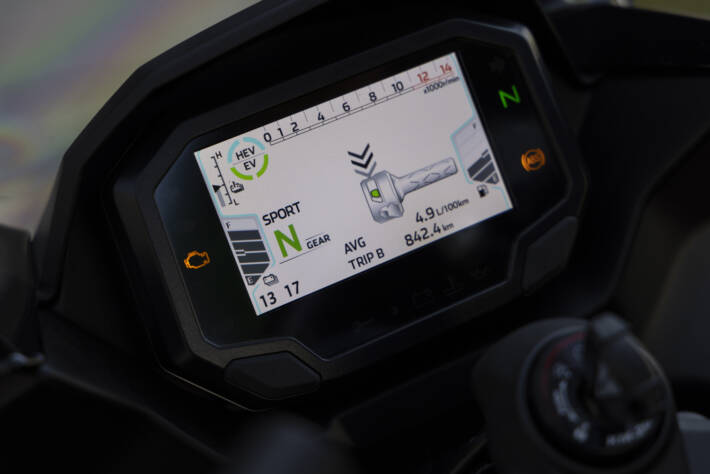
Then there’s the Eco hybrid mode: this uses the petrol engine so you have full performance, but it stops the engine when you come to a halt, and uses the electric motor to pull away, kicking in the petrol power once you’re on the move.
Eco mode has automatic gearchanges with optional manual operation, and the electric motor is used by the bike to assist acceleration. The bike also regenerates power when you’re braking or decelerating, putting energy back into the battery, and using it when you pull away from a standstill or accelerate.
That reduces the fuel consumption accordingly, and helps the bike beat a Ninja 250 on fuel: Kawasaki claims around 77mpg in Eco mode, which is pretty decent.
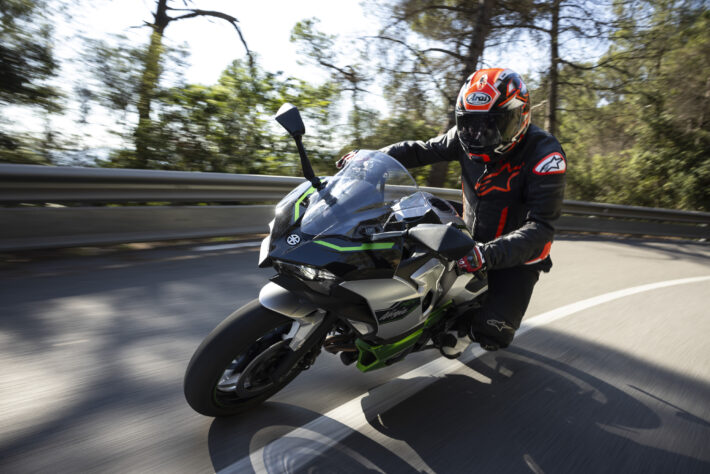
The final mode is Sport hybrid mode. That runs the petrol engine all the time, with no stop-start operation, and uses the electric motor to boost performance more than reduce fuel consumption.
It’s manual-gearbox only, and you also get access to the ‘E-boost’ button, which dumps the entire torque and power output from the electric motor into the drivetrain at the push of a button, for five seconds, rather like a little electric nitrous boost. It takes five seconds or so to regenerate between operation, but as long as the battery has charge, it can be used repeatedly.
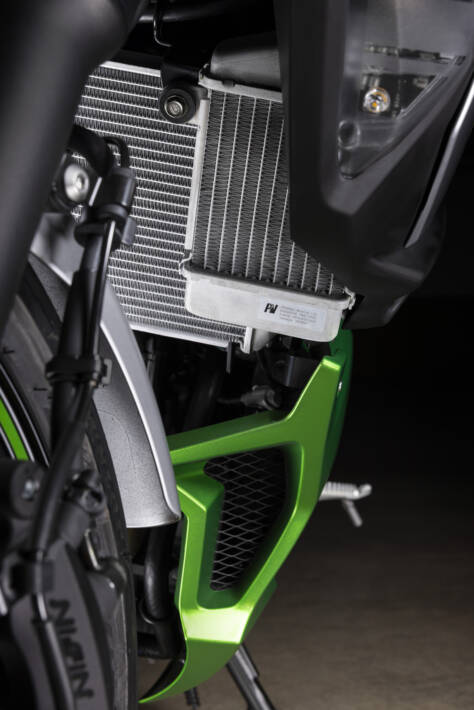
Away from the powertrain, the rest of the bike is fairly conventional. The chassis is based on parts and design from the Ninja 650 and Ninja 400, with basic light-middleweight sporty road suspension, twin-piston sliding caliper Nissin brakes, unadjustable 41mm forks and preload-only rear shock.
A long swingarm is used to improve handling with the high-torque output from the powertrain, and a steel tube trellis frame holds it all together. The full fairing has hints of ZX-10R and H2 design around the headlight, but is a little frumpy towards the back end, where it has to accommodate the 13kg battery pack.
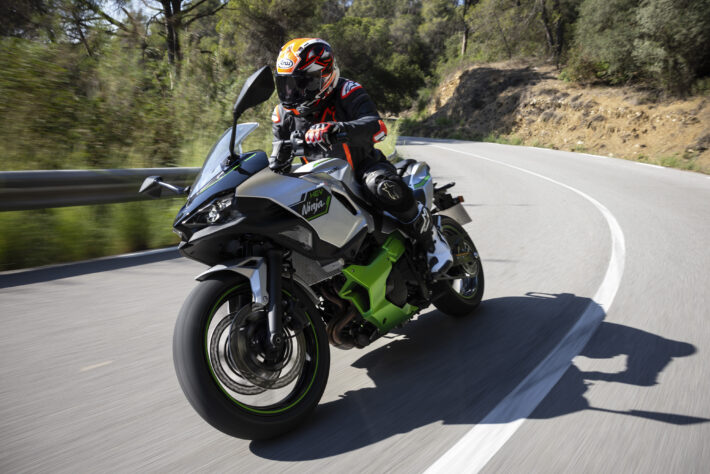
This lives under the rider seat, and that, plus the motor and electronics makes the extra 34kg of mass over a Ninja 650. The wet weight of the Ninja 7 is 227kg – chunky compared to the 193kg Ninja 650 or 168kg Ninja 400 – but it hides it well on the move.
So, that’s the basic tech.
But what is it like to ride? We’re about to find out.
The lead riders and engineers seem a little nervous about this, so they take us to a nearby wide-open car parking space, near the Barcelona docks, where we can bed ourselves in. The ride there is slightly confusing, as I juggle the electric-only mode we started off in to the Eco and Sport hybrid modes.
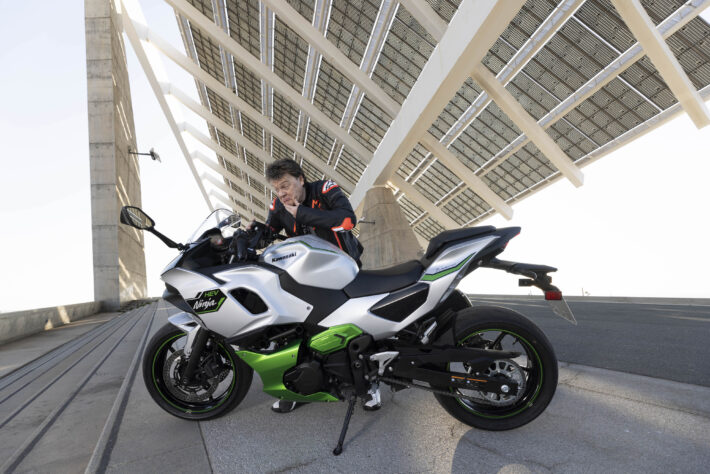
If you’ve been riding for nearly four decades like me, you have some very deep hard-wiring to your riding ‘muscle memory’, and it’s difficult not to try and change gear with your left hand and foot operating clutch and gear levers.
But neither of those exist on the Ninja 7, and you have to either engage one of the automatic modes, or change up and down with the gearshift paddles on the left switchgear.
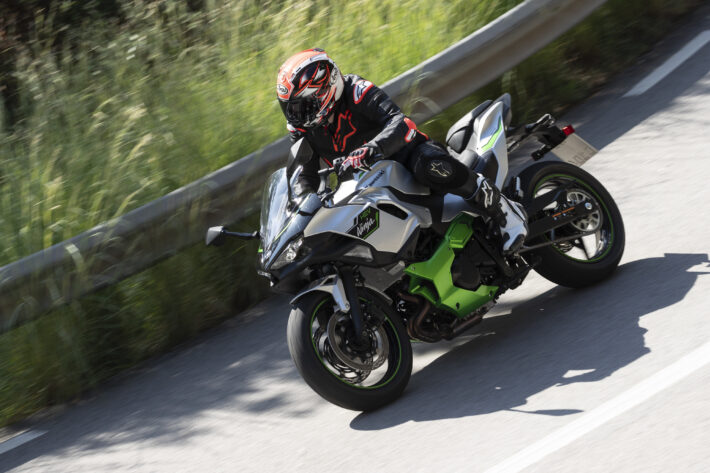
We make it to the test area though without mishap, and I get a chance to nail down the setup. It’s gradually growing on me: the EV-only mode is very simple: fully-automatic transmission, silent battery-powered drive, and only the first four gears used.
Top speed is 60kph – about 37mph – and it gets there pretty sharpish. It’s very usable around town, and while the battery gauge does go down, I easily do about five miles in this mode with plenty of charge left. It’s by no means limited to a mile or so – though Kawasaki doesn’t specify a definite range.
We get a chance to try out the Sport mode plus E-boost on a short drag strip, and it’s a lot of fun. You can engage the extra grunt at a standstill, and when you slam the gas open, the bike does shoot forward with some aggression.
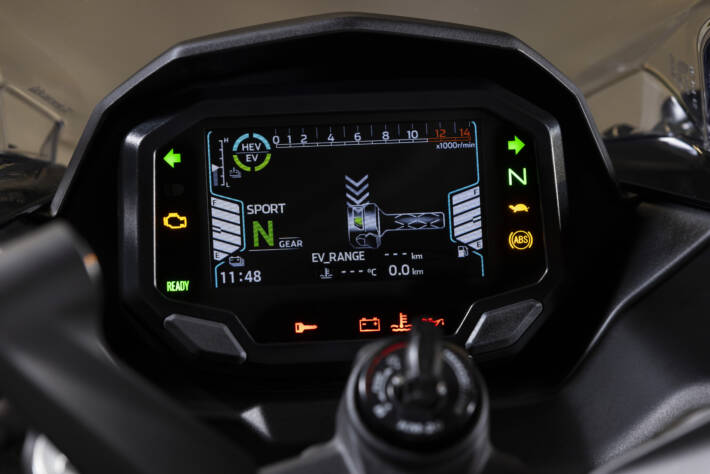
The length and weight plus the automatic clutch means it stays very stable, with no wheelying or wheelspin, just fast drive. Kawasaki showed us a video of the Ninja 7 beating a ZX-10R off the line for the first 50-60 metres, which is impressive (though it’s not clear how hard the 10R was going in the video).
Nevertheless the point remains: the Ninja 7 is no dull sluggard away from the lights.
The car park session is done, and we go out for some real riding, following the lead rider along the motorway and up into the hills. I’m still feeling my way with the mode selections: you really are re-learning the very basics of engine and transmission control, mostly down to the auto gear change.
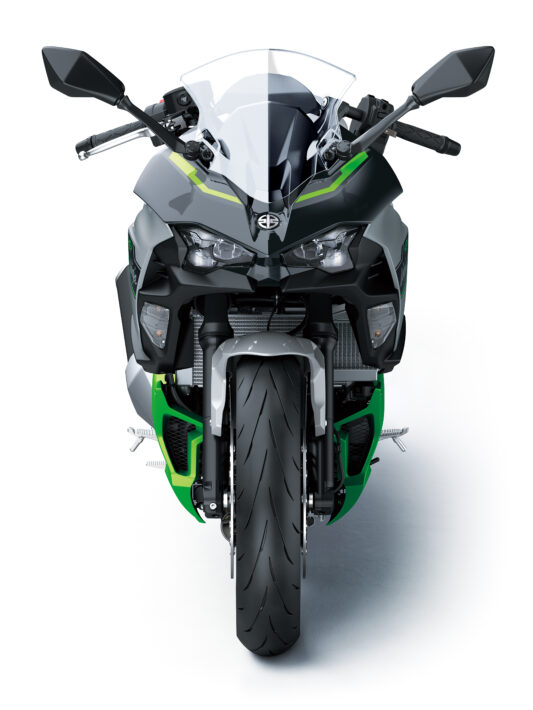
The shift paddles are easy to operate, but the computer will only change up a gear when you have the throttle open and it only changes down on a closed throttle. That sounds logical, but it’s surprising how often during a ride you want to change gear with a manual clutch and the throttle in a slightly ‘wrong’ position.
Following another bike closely through traffic on a twisty road is a tricky job, and having the minor hiccup of a missed gear shift here and there was frustrating. By the end of the morning though, I was much more used to it, and adapting my technique, making sure the throttle was in the ‘correct’ position before the gearshift up or down.
The automatic clutch is also spot-on when you’re pulling away, and you can easily feather in drive through the throttle alone with no grief.
Away from the powertrain, the rest of the bike is supremely inoffensive. The weight – 227kg wet – isn’t a problem, probably down to the location of the battery mass right under the seat.
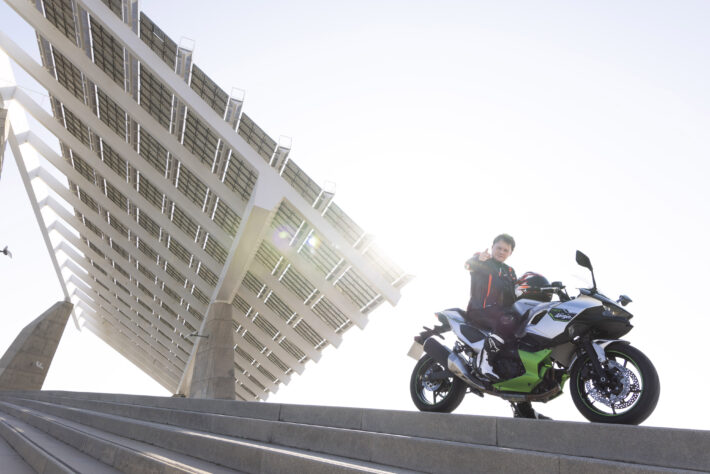
Slow speed balance is great too: you can stop with your feet up for a good few seconds at a red light, and pottering through traffic is also easy. The brakes are soft but powerful enough, with a basic ABS setup and good balance front and rear.
Haul them both on and you come to a stop pretty sharp. Ditto the suspension: the basic forks and preload-adjust monoshock are fairly anonymous, but let you know enough about what’s going on below you. The warm dry asphalt is no big test for the Dunlop Sportmax Q5A tyres, but they don’t miss a beat either.
Just as well, because the lead rider has finally overtaken all the slow cars on this mountain road, and he’s turned up the wick a bit. I’m soon riding as hard as I’d like on this tricksy piece of sinuous Spanish B-road, hammering on brakes into bends, throwing the Ninja on its ear and hitting the gas hard on the way out.
The E-boost button is a handy helper here: should you find yourself in a gear too low coming out of a bend, and struggling a little, a quick push of the boost button lifts up the little Kawasaki’s shiny green skirts and fires you forward pretty hard, faster than closing the throttle and changing down a gear would be.
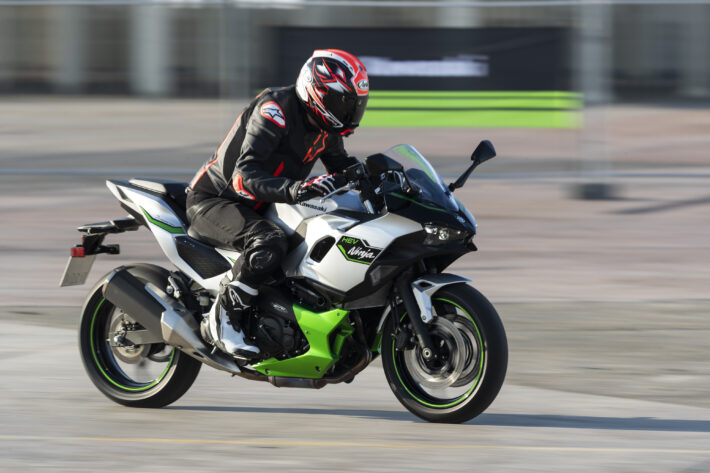
I’m sure I’d be going faster on something like a Ducati Hypermotard, but the Ninja 7 is honestly no big hardship here at all.
Later on, we’re cruising back to the hotel at the end of day one, and I’m pretty weary from a day of travelling and an early start this morning. Slipping the Ninja 7 into Eco mode, with automatic transmission, I can relax and enjoy the ride.
The engine is smooth and easy, I don’t need to think about gear changes or boost modes, I just twist and go. Even when I dip into manual gearbox mode, the clever computer changes back down to first gear automatically when you stop.
The next day, we get another few hours on the Ninja 7, and it feels completely natural. My brain has assimilated the extra modes and transmission selections overnight, and it begins to feel like second nature.
There are a couple of minor gripes: I’d like to see a cruise control option, which would be perfect in the automatic Eco mode. And it also probably needs a parking brake: you can’t leave the Ninja 7 in gear when you turn off, indeed, it’s designed so that at a halt, the clutch is pulled in, so the gearbox free-wheels no matter what gear it was left in. Be careful when parking on a slope.
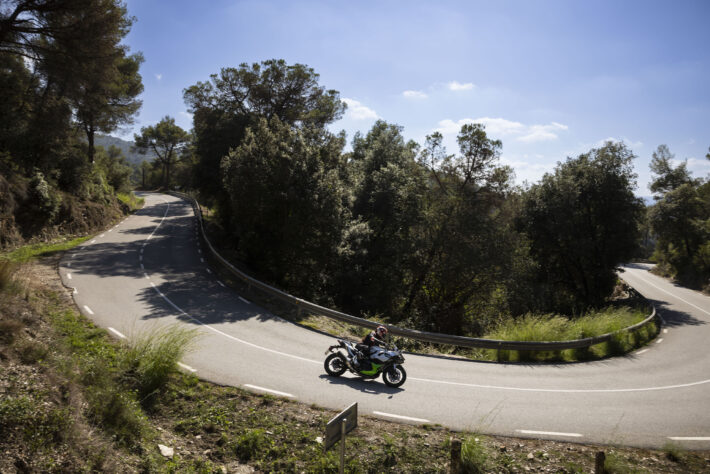
But as our time with the Ninja 7 comes to an end, I’m really quite impressed with the job Kawasaki has done. If I was being super-critical, I’d say it should probably have put this powertrain into a Versys bike first. It would really suit the useful little road-adventure tourer, and probably snatch more sales than a road sports bike. But the engineers all say that they preferred to work on a sports bike first, and fair play to them for that.
I’d be amazed if this was the final time we see this tech though: unless it utterly bombs in the market, which I doubt, I’m sure we’ll see a hybrid Versys and a hybrid Z naked before very long. As it is, Kawasaki has come out with an electric-ish bike that’s not super-expensive (price is tbc but around £12k), not too heavy, and with a great range and solid performance. Managing all that, with some revolutionary technology, is a pretty impressive job.
Kawasaki Ninja 7 technical deep-dive
Petrol engine
From the clutch forward, the Ninja 7 powertrain is actually fairly dull. A parallel twin top end has 451cc capacity from a 70×58.6mm bore and stroke, DOHC 8v cylinder head, 11.7:1 compression ratio, dual 36mm ride-by-wire throttle fuel injection and a 58bhp peak output.
It’s based on the same engine as in the new Eliminator 500, but with more power, and lots of alterations to suit the Ninja 7. One big change is the starter and alternator, which have been replaced by an integrated starter/generator unit on the left hand side of the crankshaft.
That is in addition to the 9bhp traction motor: the bike needs to be able to start while the clutch has disconnected the traction motor from the internal combustion engine, hence two motors, rather than the single motor seen on some hybrid car powertrains.
Interestingly, the oil pump has a special one-way clutch drive from the transmission, so it keeps running when the petrol engine is turned off, presumably to keep the main clutch and the gearbox lubricated and cooled. It’s not clear if it also keeps oil pressure up in the main engine lube circuits when the engine is off.
Electric motor
This is the same motor as used on the Z e-1 electric-only bike, but with water cooling added (you can see the small extra radiator for this just in front of the main petrol engine’s radiator).
It’s connected to the drive train by a chain that sits just behind the computer-controlled clutch, so the motor is always connected to the gearbox input shaft, freewheeling when not powered, and able to kick in to add drive to the back tyre at any point, whether the petrol motor is operating or not.
Software control
This is the really tricky part, and had its own huge development team during the four-year Ninja 7 design stage. It’s easy enough to use once you get your head around it: there are four buttons on the left hand switchgear to select Eco or Sport hybrid modes, EV battery-only mode, and automatic or manual gearbox operation.
There’s also a smaller button to choose the ‘Walk’ mode, which has limited speed (5kph) and a reverse function to help with parking or slow-speed manoeuvring.
Switching between the main modes is simple enough, but to move into EV mode you need to be going less than 25kph and be in a gear lower than fourth.
Some of the mode changes need a few seconds with the button held in, and at first it feels ponderous, until you realise you need to hold the button and wait.
Gear changes in manual mode are quick and easy enough with the two finger-and-thumb buttons on the left hand bar.
Battery pack
The Ninja 7 has a 13kg 48 volt lithium ion battery pack that is fitted under the rider’s seat. It isn’t a plug-in hybrid, rather the battery is only charged from a generator on the engine that kicks in when you’re off the gas.
That regenerative charging means the bike is capturing energy that would otherwise be wasted, and uses it for the electric motor. Because of that, Kawasaki claims the Ninja 7 uses less fuel than a Ninja 250, nearly 77mpg in Eco mode.
There’s also a normal 12-volt battery to power the usual bike electrics: lights, fuel injection, dash, etc. A voltage convertor links the two systems, so if you somehow managed to have a flat 12v battery, the 48v side will support it.
The battery pack is air-cooled: the green duct on the right hand side of the bike delivers a cooling breeze when on the move. The left-hand air duct is to cool the integrated starter /generator on the left side of the engine.
Chassis
The development team was obviously concentrating on the powertrain, so the chassis is extremely conventional, and similar to the Ninja 650 and 400 designs. There’s a steel trellis frame like on the 650, and a plain box-section swingarm with preload-adjustable monoshock.
The front end uses a 41mm non-adjustable fork, with twin-piston Nissin brake calipers and dual 300mm discs, again like the Ninja 650. Dunlop Sportmax Q5A tyres are fitted in middleweight sizes – 120/70 17 front and 160/60 17 rear, with cast aluminium wheels.